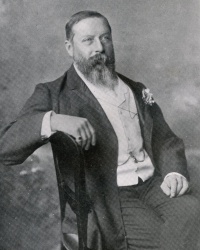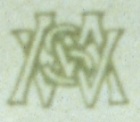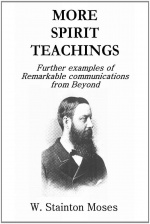William Stainton Moses
William Stainton Moses (originally Moseyn) (November 5, 1839 - September 5, 1892) was an English clergyman, writer, and editor. He was a Spiritualist and member of the Theosophical Society.
Early life and career
William Stainton Moses was born on November 5, 1839, in Donnington in Lincolnshire, England. He was educated at Bedford School, University College School, London and Exeter College, Oxford, where he earned a Master of Arts degree.
He was ordained as a priest of the Church of England, and at age 24 began his ministry at Kirk Maughold, near Ramsey, in the Isle of Man. There he was well regarded by parishioners, who appreciated his active aid during a smallpox outbreak. After four years he moved to St. George's, another church on the Isle of Man. During these years he also began to submit articles for popular periodicals such as Punch. In 1870 he took a position as curate in Dorsetshire, but recurring health challenges forced him to abandon parish work. He spent the next seven years tutoring the son of Stanhope Templeman Speer, the doctor who had helped him recover from illness.[1]
In 1871 he became a lecturer in philology at University of London, and a Professor of Classics and English at the University College School in London.[2]
Spiritualism
Rev. Stainton Moses became interested in Spiritualism. He attended his first séance with Lottie Fowler in 1872. Five months after his introduction to spiritualism, he reported to have had his first experience of levitation. Eventually, he developed remarkable psychic abilities and began to publish the information that came through his automatic writing in his books.
Imperator
One of Stainton Moses' "controls" or spirit guides was called "Imperator". He first identified himself under this name on September 19, 1872, but later, yielding to entreaties by Moses, he revealed, on July 6, 1873, in Book IV of his writings that he was the biblical prophet Malachi. His communications were not written by Imperator himself, but by "Rector." The signature was "Imperator S. D. (Servus Dei)" or "I.S.D.," preceded by a Latin cross at first, then later by a crown.[3]
In The Mahatma Letters Imperator is frequently designated by the cross "+". He claimed to know nothing about "the Brothers", and therefore Moses did not believe in them.
Imperator's identity is not clear. In letter No. 38, Master K.H. suggests that different entities communicated with Moses under that name, sometimes it being his own Higher Self, at other times one of the Adepts, and in other occasions some other entity or entities. In 1882 the Master refers to Imperator as a "high disembodied shell, that he [Staiton Moses] mistakes for the "Imperator" of the early days of his mediumship".[4]
disembodied shell, that he mistakes for the "Imperator" of the early days of his mediumship
Theosophical involvement
Stainton Moses contacted Col. Olcott early 1875, before the founding of the Theosophical Society, and became a close friend of him and H. P. Blavatsky. In the autumn of 1876 Mme. Blavatsky precipitated a painting that showed his progress in his attempt to project hi Double. In October of that year he was put on probation (see below).
At this time the T.S. was present only in New York. S. Moses was interested in belonging to a secret society, preferably with some kind of masonic ritual, to discuss "the deeper mysteries of Theosophy" and "to have esoteric phenomenal experiences".[5] Although the T.S. did not fulfill all his expectations, he thought it the best available option. On December 11, 1877, he became one of the founders of the "British Theosophical Society" which would be known later as the London Lodge. However, he soon became unhappy both with the Society and its Founders.
Mahatma Letters
Rev. Stainton Moses is mentioned in several of The Mahatma Letters to A. P. Sinnett. There, we find evidence that he was in touch with one of the Masters of Wisdom and was being helped in his training, although he was not aware of it. As Master K.H. wrote:
In every letter of his he clamoured for a "living Brother." To her [Mme. Blavatsky's] unequivocal statement that there was one already having charge of him, he strongly objected. When helped to get free from his too material body, absent from it for hours and days sometimes his empty machine run during that period from afar and by external, living influence—as soon as back, he would begin labouring under the irradicable impression of having been all that time the vehicle for another intelligence, a disembodied not embodied Spirit, truth never once flashing across his mind.[6]
From the letters it also seems that he was put on probation. The Master wrote:
In October, 1876, they [the Brothers of the Shadow] had begun their work upon him. "I am fighting" — he wrote — "a hand to hand battle with all the legions of the Fiend for the past three weeks. My nights are made hideous with their torments, temptations and foul suggestions. I see them all around, glaring at me, gabbling, howling, grinning! Every form of filthy suggestion, of bewildering doubt, of mad and shuddering fear is upon me . . . I can understand Zanoni's Dweller now . . . I have not wavered yet . . . and their temptations are fainter, the presence less near, the horror less. . . ."
One night she [i.e., Mme. Blavatsky] had prostrated herself before her Superior, one of the few they fear, praying him to wave his hand across the ocean, lest S.M. should die, and the Theos. Soc. lose its best subject. "He must be tried" was the answer.[7]
S. Moses wrote one of the letters in that collection, addressed to A. P. Sinnett on November 26, 1881, in which he discussed mediumship. It is letter number 38 in the chronological sequence (number 90 in Barker editions).
By the end of 1881 A. P. Sinnett sent Moses some criticism that Master K.H. had made about him, which caused Moses' severance with the Theosophical Society. In spite of his criticisms, the Master regarded him as "the best, the most reliable of mediums".[8]
Later years
In 1881 and 1882, Moses helped to found the Society for Psychical Research. In 1884, Moses was a founding member, together with Rogers, of the London Spiritualist Alliance, afterwards the College of Psychic Studies.
He died on September 5, 1892.
Writings
Rev. Stainton Moses became publisher and editor of the periodical Light. He wrote for spiritualistic and Theosophical journals under the nom-de-plume "M. A. (Oxon.)"[9] reflecting his academic credentials, where Oxon. is an abbreviation for the University of Oxford (Latin name Universitas Oxoniensis).
The "Early Story of TS" was an article published in two parts in Light, July 9, 1892, pp. 330-32; and July 23, 1892, pp. 354-57. In this article Moses reviewed Olcott's Old Diary Leaves when they were first published in The Theosophist beginning with the March 1892 issue. Moses also published a transcription of eight letters that he received from Olcott during the years 1875-76. Some of the letters give Colonel Olcott's early views of Madame Blavatsky.[10]
Stainton Moses wrote these books and pamphlets, listed chronologically:
- The Slade Case: Its Facts and Its Lessons. A Record and a Warning. London: J. Burns, 1877. Pamphlet.
- Psychography: a Treatise on One of the Objective Forms of Psychic or Spiritual Phenomena. London: W.H. Harrison, 1878. Available at Hathitrust.
- Spirit Identity. London, W.H. Harrison, 1879. London: London Spiritualist Alliance, 1902. Later editions.
- Higher Aspects of Spiritualism. London: E.W. Allen & Co. ; Boston: Colby & Rich ; Chicago: Religio-Philosophical Publishing House, 1880. London: London Spiritualist Alliance, 1908.
- Spirit Teachings. London, Psychological Press Association, 1883. Memorial edition - London, London Spiritualist Alliance, 1898. "Through the mediumship of William Stainton Moses (M.A. Oxon)." Available at Hathitrust. There were many printings and at least 9 editions. Dutch translation, 1891. French translation, 1899.
- The Mystic Voices of Heaven: or, The Supernatural Revealed in the Natural Science of the Heavens. London: Elliot Stock, 1886.
- More Spirit Teachings. London: L.N. Fowler, Camelot Press, 1892. With other authors. Several editions.
He was also involved in these works:
- Gregory, William. Animal Magnetism, or, Mesmerism and Its Phenomena. 1st edition about 1877. Introductions by Stainton Moses appeared in 3rd and later editions. 3rd, and slightly rev. and abridged, ed. - London: Psychological Press Association, and E.W. Allen, 1884. 4th edition - London: G. Redway, 1898. London: Nichols & Co., 1909. Many more editions and printings.
Online resources
Articles
- Early Story of TS by William Stainton Moses
- Colonel Olcott on the Kiddle Plagiarism by "M.A. (Oxon.)"
- William Stainton Moses at Theosopedia.
- William Stainton Moses Biography at Spiritwritings.com
- "Imperator" at Gale Encyclopedia of Occultism & Parapsychology.
Additional resources
Articles
- Hamill, John, "Additional Light on William Stainton Moses and The Theosophical Society", Theosophical History, Volume 7, (July 1999).
Books
- Bennett, Edward T. Psychic Phenomena: A Brief Account of the Physical Manifestations Observed in Psychical Research. New York: Brentano's, 1909. Available at Project Gutenberg and Hathitrust.
- Buckland, Raymond. The Spirit Book: the Encyclopedia of Clairvoyance, Channeling, and Spirit Communication. Canton, Mich.: Visible Ink, 2006.
- Leaf, Horace. The World's Greatest Mediums. London, Spiritualist Association of Great Britain, 1966.
- Lillie, Arthur. Modern Mystics and Modern Magic; containing a full biography of the Rev. William Stainton Moses, together with sketches of Swedenborg, Boehme, Madame Guyon, the Illuminati, the kabbalists, the theosophists, the French spiritists, the Society of Psychical Research, etc.. New York: C. Scribner's Sons, 1894. Available at Hathitrust.
- Oppenheim, Janet. The Other World: Spiritualism and Psychical Research in England, 1850-1914. Cambridge: Cambridge University Press, 1985 .
- Trethewy, A. W. The "controls" of Stainton Moses ("M. A. Oxon."). London: Hurst & Blackett, 1923.
- Vice, Diana. The Stainton-Moses Communications through Diana Vice. Taunton (Nethercot Mill, Combe Florey, Taunton, Somerset: Martigan Publications, 1973. Purporting to be communications received by the South African medium, Diana Vice, from alleged spirit entities, under the control of one presumed to be the late Rev. William Stainton-Moses.
Notes
- ↑ William Stainton Moses Biography, at Spiritwritings.com
- ↑ The International Theosophical Year Book 1938 (Adyar, Madras, India: Theosophical Publishing House, 1938): 202.
- ↑ "Imperator" at Gale Encyclopedia of Occultism & Parapsychology.
- ↑ Vicente Hao Chin, Jr., The Mahatma Letters to A.P. Sinnett in chronological sequence No. 93b (Quezon City: Theosophical Publishing House, 1993), 329.
- ↑ Hamill, John, "Additional Light on William Stainton Moses and The Theosophical Society", Theosophical History, Volume 7, (July 1999), p. 252-253.
- ↑ Vicente Hao Chin, Jr., The Mahatma Letters to A.P. Sinnett in chronological sequence No. 18 (Quezon City: Theosophical Publishing House, 1993), ???.
- ↑ Vicente Hao Chin, Jr., The Mahatma Letters to A.P. Sinnett in chronological sequence No. 18 (Quezon City: Theosophical Publishing House, 1993), ???.
- ↑ Vicente Hao Chin, Jr., The Mahatma Letters to A.P. Sinnett in chronological sequence No. 93b (Quezon City: Theosophical Publishing House, 1993), 329.
- ↑ The International Theosophical Year Book 1938 (Adyar, Madras, India: Theosophical Publishing House, 1938): 202.
- ↑ Available at Theosophical Society in America Web page [1] and at the Blavatsky Archives Web page. [2]



